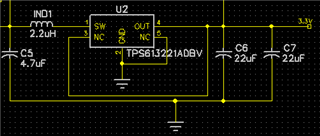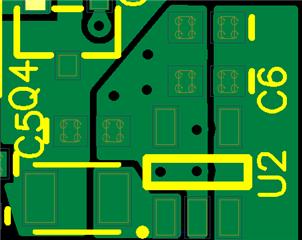The TPS613221A (3.3v output) drops the output voltage if Vin goes below 1.28v with a constant 100mA load. Vin 1.28v to 1.5v gives 3.3v out. 1.27v in, out=3.01v. 1.25v in, out 2.94v. 1.2v in, out 2.8v. We tried 2 different inductors: Murata 2.2uH 80mOhm typical, 1.3A rated and Samsung 4.7uH, 130mOhm, 1.6A rated, 2.2A Isat. With the 4.7uH, efficiency improved (lower input current), but output voltage dropped at the exact same input voltage. There's a 4.7uF cap just before the inductor and two 22uF on the output (plus the decoupling caps at several components elsewhere on the board). The PCB layout is almost identical to figure 40 in datasheet (SLVSDY5D –JANUARY 2018–REVISED FEBRUARY 2019) but without the diode and snubber (large copper connects pin 5 to GND pin 2, and large copper connects pin 3 to OUT pin 4). Note: we added a diode and snubber, and the exact same drop occurred at the same input and output voltages. It is a 2-layer PCB. The bottom layer is a ground plane below this booster circuit. Figure 3 and 4 (in the same datasheet) show the output still working even down to 0.9v input (though efficiency drops), but it does not work below 1.28v input. Suggestions, please.




